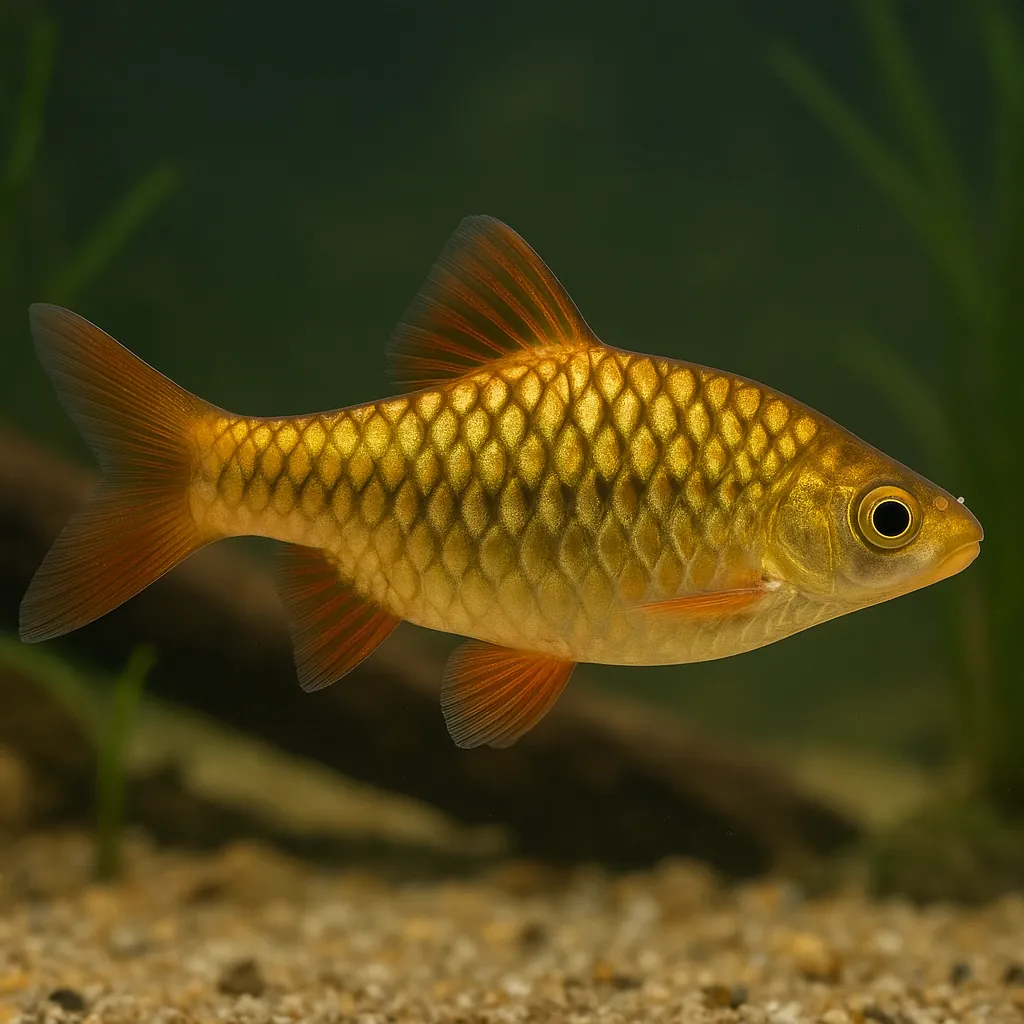
Golden barb
Introduction
The Golden Barb (Pethia gelius), also known as the Golden Dwarf Barb, is a vibrant and active freshwater fish that has become a favorite among aquarists. Its striking golden coloration and peaceful nature make it an appealing addition to community tanks. Suitable for both beginners and intermediate fishkeepers, the Golden Barb is relatively hardy and adapts well to various aquarium conditions.
Care and Environment
Providing optimal care for the Golden Barb involves replicating its natural habitat and meeting its specific needs.
What is the minimum tank size required for a Golden Barb?
A minimum tank size of 20 gallons (approximately 75 liters) is recommended to accommodate a small group of Golden Barbs, as they are schooling fish that thrive in groups of at least five.
What are the ideal water parameters for Golden Barbs?
Golden Barbs prefer water temperatures between 18°C and 24°C (64°F to 75°F), a pH range of 6.0 to 8.0, and water hardness between 5 to 19 dGH. Maintaining these parameters helps ensure their health and vitality.
How should the aquarium be set up for Golden Barbs?
The aquarium should include a dark, soft substrate, such as peat, to mimic their natural environment. Incorporate plenty of plants like Cryptocoryne species and provide hiding spots with driftwood or roots. Ensure there is ample open swimming space, as Golden Barbs are active swimmers. A moderate water flow and well-oxygenated conditions are beneficial.
What is the recommended diet for Golden Barbs?
Golden Barbs are omnivorous and enjoy a varied diet. They readily accept high-quality flake foods, micro pellets, and granules. Supplement their diet with live or frozen foods such as daphnia, brine shrimp, or bloodworms. Occasional feedings of blanched vegetables like spinach or zucchini are also beneficial. Feed small portions 1–2 times daily.
Are there any specific challenges in keeping Golden Barbs?
Golden Barbs are generally hardy but can be sensitive to high temperatures. It's important to monitor water conditions regularly and perform routine maintenance to prevent stress and disease. Additionally, they may nip at soft-leaved plants if not well-fed, so providing a balanced diet is crucial.
Origin and Habitat
Golden Barbs are native to South Asia, specifically found in the river basins of the Ganges and Brahmaputra in northern India, Nepal, and Bangladesh. They inhabit slow-moving rivers, streams, and rice paddies with soft to moderately hard water. These environments are typically shallow and densely planted, providing ample cover and feeding opportunities.
What type of water bodies do Golden Barbs inhabit in the wild?
In the wild, Golden Barbs are found in slow-moving rivers, streams, and rice paddies with soft to moderately hard water.
What are the typical conditions of their natural habitat?
Their natural habitats are shallow, densely vegetated waters with soft to moderately hard water, providing ample cover and feeding opportunities.
Temperament and Compatibility
Golden Barbs are peaceful, schooling fish that thrive in groups of at least five. They are active swimmers and can coexist harmoniously with other non-aggressive species of similar size.
Are Golden Barbs suitable for community tanks?
Yes, Golden Barbs are well-suited for community tanks due to their peaceful nature and compatibility with other non-aggressive species.
What are some ideal tank mates for Golden Barbs?
Suitable tank mates include Zebra Danios, Cherry Barbs, Corydoras Catfish, and Harlequin Rasboras. It's advisable to avoid housing them with long-finned fish like Bettas and Angelfish, as Golden Barbs may nip at their fins.
How do Golden Barbs behave in a group setting?
In a group setting, Golden Barbs exhibit natural shoaling behavior, which helps reduce stress and encourages more active and vibrant displays.
Interesting Facts
Golden Barbs are known for their adaptability and have been successfully bred in captivity, making them widely available in the aquarium trade. They are egg scatterers, laying eggs over fine-leaved plants or spawning mops. After spawning, it's important to remove the adults to prevent them from eating the eggs. The eggs typically hatch within 24–36 hours, and the fry become free-swimming in 2–3 days.
How long do Golden Barbs typically live?
With proper care, Golden Barbs can live between 4 to 6 years in a well-maintained aquarium.
Do Golden Barbs have any unique behaviors?
Golden Barbs are known for their lively and playful nature, often establishing a pecking order within their group, which can be fascinating to observe.
Are Golden Barbs prone to jumping out of the tank?
Yes, Golden Barbs are excellent jumpers, so it's essential to have a well-secured aquarium lid to prevent them from escaping.
Sources
All information in this article has been gathered from the following reputable sources:
Overview
Recommended Tank Size 30.4 Gallons (for groups of 5 or more) |
Minimum Group Size 5 |
Minimum Tank Volume 19.8 Gallons |
Maximum Adult Length 2 inches |
Average Adult Length 2 inches |
Shoaling (6+ required) Yes |
Preferred Water Type Freshwater, soft to moderately hard, slightly acidic to neutral |
Temperature Range (°C) 18–24 |
pH Range 6.0–8.0 |
Water Hardness (dGH) 5–19 |
Typical Lifespan (years) 4 years |